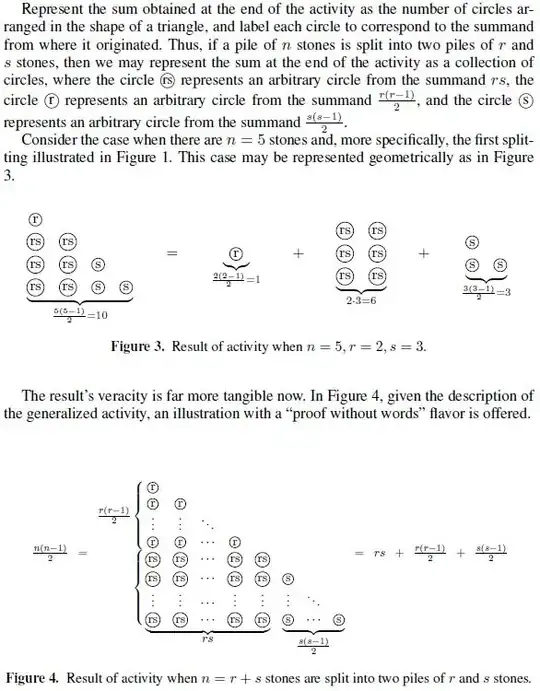Problem: Suppose you begin with a pile of $n$ stones and split this pile into $n$ piles of one stone each by successively splitting a pile of stones into two smaller piles. Each time you split a pile, multiply the number of stones in each of the two smaller piles you form, so that if these piles have $r$ and $s$ stones in them, respectively, you compute $rs$. Once you have finished splitting the piles, calculate the sum of the products computed at each step. Does the order of how you split the piles effect the final summation?
Simple strong induction proof: It looks as if the sum will always be $n(n-1)/2$. Briefly, the pile of $n$ stones is split into piles of $r$ and $s=n-r$ stones, where $r$ is a positive integer less than $n$. The key inductive step for the strong induction proof is $$ rs+\frac{r(r-1)}{2}+\frac{s(s-1)}{2}=\frac{(r+s)(r+s-1)}{2}=\frac{n(n-1)}{2}. $$
My question: Are there any neat ways to interpret this problem and its solution?
This problem appears in several sources where the result is often included and you are asked to prove it using induction. I noticed that there are a number of ways to view this problem and its concomitant analogues (but I am lacking a good, intuitive geometric interpretation or analysis):
Combinatorics: Instead of summing the products for all of the pile splittings for $n$ stones, label the stones $1$ through $n$ and let them be elements of a set $M$. For every split, pair all of the stones in the first set with all of the stones in the second set. Every pair produced in this way appears exactly once during the activity. The terms in the sum are the number of new pairs generated after every split. Consider the power set $\mathcal{P}(M)$. By making such pairings, we have generated all distinct 2-element subsets of $\mathcal{P}(M)$.
Graph theory: Instead of summing the products for all of the pile splittings for $n$ stones, scatter the stones on a flat surface. Mathematically speaking, let $P_1,P_2,\ldots,P_n$ be $n$ points in a plane where no three points are collinear. Each point represents a stone or vertex. With this understanding, the situation may be modeled by a simple graph $G=(V,E)$. If we were to connect every pair of vertices with an edge for a graph $G$, that is, construct the complete graph $G=K_n$, then the number of edges for $K_n$ would be the same as the sum of the products in the original activity.
Combinatorics and graph theory: We can actually give a sort of restatement of the key inductive step that was used to prove the result of the activity by considering an exercise that appears in D.B. West's Introduction to Graph Theory:
$\underline{\text{Exercise:}}$ Use complete graphs and counting arguments to prove that $$ \binom{n}{2} = \binom{k}{2} + k(n-k) +\binom{n-k}{2}\quad|\quad 0\leq k\leq n. $$ Proof. Consider the complete graph $K_n$ which has $\binom{n}{2}$ edges. If we partition the vertices of $K_n$ into a set with $k$ elements and a set with $n-k$ elements, then we can count the edges as those within one block of the partition and those choosing a vertex from each. Consequently, the number of edges is given by $k(n-k)+\binom{k}{2}+\binom{n-k}{2}$.
I think these are some pretty cool ways to look at the original problem/activity. A geometric interpretation (or other) that added some intuition as to why the result of the activity is true would be quite nice.
